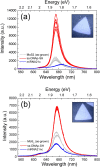Breast cancer biomarker detection through the photoluminescence of epitaxial monolayer MoS2 flakes
- PMID: 32994454
- PMCID: PMC7525660
- DOI: 10.1038/s41598-020-73029-9
Breast cancer biomarker detection through the photoluminescence of epitaxial monolayer MoS2 flakes
Abstract
In this work we report on the characterization and biological functionalization of 2D MoS2 flakes, epitaxially grown on sapphire, to develop an optical biosensor for the breast cancer biomarker miRNA21. The MoS2 flakes were modified with a thiolated DNA probe complementary to the target biomarker. Based on the photoluminescence of MoS2, the hybridization events were analyzed for the target (miRNA21c) and the control non-complementary sequence (miRNA21nc). A specific redshift was observed for the hybridization with miRNA21c, but not for the control, demonstrating the biomarker recognition via PL. The homogeneity of these MoS2 platforms was verified with microscopic maps. The detailed spectroscopic analysis of the spectra reveals changes in the trion to excitation ratio, being the redshift after the hybridization ascribed to both peaks. The results demonstrate the benefits of optical biosensors based on MoS2 monolayer for future commercial devices.
Conflict of interest statement
The authors declare no competing interests.
Figures






References
-
- Mahfoud OK, et al. Detection of ErbB2: Nanotechnological solutions for clinical diagnostics. RSC Adv. 2014;4:3422–3442. doi: 10.1039/C3RA45401K. - DOI
Publication types
MeSH terms
Substances
LinkOut - more resources
Full Text Sources
Medical

